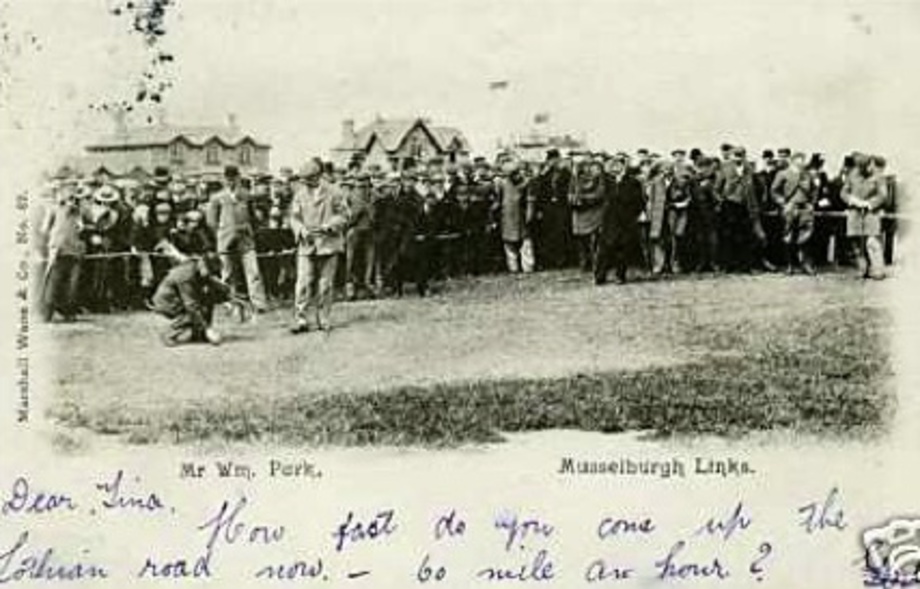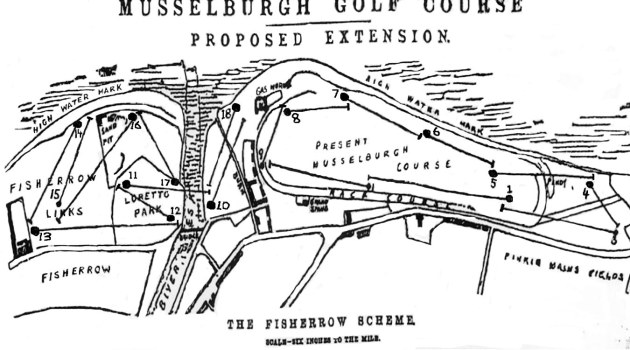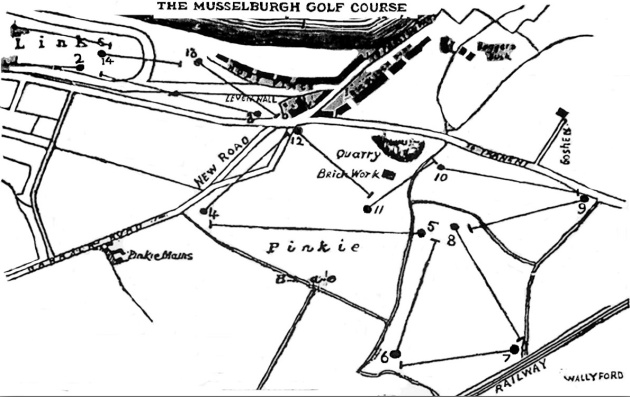
Musselburgh Old Course Extension
Musselburgh was one of the three original venues for the Open Championship, together with Prestwick and St Andrews. It was played there on six occasions between 1874 and 1889, but was taken off the roster in 1892 when the rules for the Open stipulated that it would be played over rounds on an eighteen hole course. This cause consternation in the town because much of its prosperity arose from golf, and its former pre-eminence in the golfing world became greatly diminished. The only way to recover this loss of status was to extend the old course to 18 holes.
The first move came in April 1893 when it was suggested that the extension could be achieved in two ways, firstly, by locating the additional holes to the west on the Fisherrow Links There were already a five-hole golf course, football and cricket pitches, which would have to be replaced, and which would not be so convenient as the exiting facilities. Further the local fishermen had long had a right to dry their nets on the unused parts of the links.
The alternative scheme was by an extension to the east on new land at Levenhall. The opponents of the Levenhall scheme cited the unsuitable soil and ground conditions and the expense necessarily incurred to make it suitable for golfing. Opinion was sharply divided on which would be the best course of action. However, action was not evident as, like most public bodies, the Town Council referred the matter to a sub-committee for further examination.
(Edinburgh Evening News 28.4.1893)
But the Levenhall scheme had its proponents, one of whom was prepared to voice his feelings publicly:-
(To the Editor of the Evening Dispatch)
Musselburgh, April 29, 1893
Sir, - I am glad to see that you are taking up this much-needed golf extension scheme at Musselburgh. The Fisherrow scheme, if carried out, might be objected to as a danger to people using the links for other purposes, and would be a great drawback to golfers. By acquiring the brickwork and adjoining parks to the south-east of Musselburgh Links the number of holes could easily be got, and it would have this great advantage – that the game could be played without interference if acquired for this purpose. I think the Town Council should leave it to the golfers to carry it out, as it would prevent football and other clubs from having any claim. I send you a map of the ground (shown above). Golfers, after holing out at No 3 would cross the road and tee on the other side, and, after going the new round and holing out at No 12, would re-cross and drive off at Forman’s. They would avoid the danger of playing across the road. This scheme, if carried out, would not interfere with Dr Almond’s cricket ground, and the ball-snatching fiend would cease from troubling, and the golfer’s whole mind would be on his game. – I am, &c. Old Golfer
Despite all the discussions, no outcome was reached and matters drifted on into 1894.
“There as been considerable discussion of the question of the Musselburgh Golf Course extension. The Green Sub-Committee, consisting of Baillie Sharp, and Messrs James Gibson and A W Millar, have been in conference on the question. The extension seaward is not held in high favour with them, on the ground that the present generation might never drive a ball over the 18-hole course reclaimed from the sea. What the golfers want is ground at the present moment, and that is obtainable at a rent from the Pinkie estate, owned by General Sir William Hope. The strip of land directly fronting on the links between the Linksfield and Forman’s holes. which is feuing at the rate of £30 per acre, is not required and is not sought. What is requires is a belt of ground comprising fifty-two acres in extent, taking in four fields which stretch as nearly as possible south-east from Forman’s. While the correspondence was going on in the Dispatch a year ago a sketch of this very course, drawn to scale. was published. We reproduce it here. If this course was laid out as suggested in the sketch, the player would cross the road and tee in the quarry field for his fourth. The pitch of this hole would be 250 yards. The drive would cross a bend in the road according to the position of the road at present, but as the ground on each side of the road belongs to Sir William Hope, it was proposes that a new thoroughfare should be formed, thus doing away with the bend. The pitches for the succeeding holes would be as follows: fifth, 350 yards; sixth, 200 yards; seventh, 300 yards; eighth, 210 yards; ninth; 200 yards; tenth, 280 yards; eleventh, 200 yards; twelfth; 300 yards; and so onto the links again. It appears that Sir William Hope is favourable to the letting of the ground for such purposes, and a meeting of the Green Committee will be held on Friday night at which a report of progress in the matter will be made. Of course it is obvious that the adoption of this extension would not preclude an experiment with the other proposal to recover ground from the sea, which many think ought to be tried at once at a moderate cost.” (Edinburgh Dispatch 24.10.1894)
"A new proposition surfaced which, although a possible solution, served mainly to generate more discussion in the Council, delaying a solution yet again. “Until the main work was finished nothing would be done to the portion at Fisherrow, which it is intended to lay out as a general recreation ground. After making all due allowance for any delay likely to arise from storms etc, the projector is confident of having the Musselburgh portion ready for play in less than 10 tears, and the whole finished in 13 years. Total cost £5000."
(Edinburgh Evening News 5.11.1894)
“So far as can be gathered from the present crude state of the reports, it would appear that a new proposal had been made for extending the course by Fisherrow without including the Fisherrow Links, which hitherto have proved the stumbling block in that direction. The Committee in charge of the scheme fully discussed the difficulties likely to arise with the fishermen and others if these links were taken over, and so to obviate these the convenor Councillor Henderson has proposed a scheme to utilise the ground around the grandstand, the present portion used as a sand pit near the gas works, and Goose Green. With an alteration on the existing course, and the inclusion of the mentioned ground, there should be enough ground for a 18-hole course. This could be improved upon if the council was to purchase the McKinley Park on the other side of the River Eden, which is available for sale. An excellent course could be available in about a year’s time at an overall cost not exceeding £3200.
Negotiations on the Levenhall scheme were going very slowly. The compensation required by the tenant of the land is more than originally thought, and it would take three to four years to put the course into a playable condition which would cost around £350, in addition to the cost of the lease.
The Seaward scheme is by far the most complicated, and thus the conclusions will be the slowest to be finalised. However, it is estimated that cost will be over £4000, and it would require at least 10 years to complete.” (Edinburgh Evening News 22.12.1894)
By December 1894, there was considerable dismay over the dilatory manner The Town Council was dealing with the proposed extension, Opinion was divided over which scheme was the better, although a good number of the more prominent players favoured the Levenhall scheme. There was a suggestion that if the Town Council would support them the players might be inclined to take over the fields at Levenhall and lay them out at their own expense. They would charge a small fee for permission to play over that portion. This, however, could only be effected with Council support. The Fisherrow schme was still in the mix, but the seaward scheme was not in much favour.
“For nearly nine months past Musselburgh Town Council have been considering the advisability of extending the present nine-hole course into one of eighteen holes. Various schemes were submitted, such as taking in additional land, and the reclamation of sandbanks lying seaward from the present course, but as the expense was likely to prove larger than the Council cared to venture upon these were discarded. A feasible scheme was to convert the present links into 14 holes, and by utilising waste ground between the clubhouses and the Esk, secure the additional four. The 14 holes on the links were laid out, and yesterday, in presence of a number of the Town Council, several golfers played over the new round. A considerable amount of cross-driving is necessary, and this at some places not only interferes with the play, but proves absolutely dangerous. Among golfers the general opinion is that there is not space for 14 holes. The matter will not proceed further until the sanction of the Town Council be obtained. The cost of laying out the new portion, should it be proceeded with, will not exceed £200.” (Glasgow Herald 25.3.1895)
“At a meeting of the Green Committee of Musselburgh Town Council last night, a letter from Mr J Anderson, secretary of the committee appointed at a meeting of golfers last week to meet with the Town Council upon the proposed reclamation of the sandbanks lying seaward from the links with the object of extending the golf course, intimating that three of their number had been appointed to meet with a like number from the Town Council. The Green Committee appointed Treasurers White and Simpson and Mr Councillor Gibb to hold a conference with the three representatives of the Citizens’ Committee on Monday night.”
(Edinburgh Evening News 4.10.1895)
The outcome of this conference has not been found, nor have further mentions of the extension, until 1905.
“In connection with the extending of Musselburgh Links from a nine to an eighteen hole course, a question which has recently been revived, a private meeting was held in the clubhouse of the Musselburgh New Club last night. By invitation representatives were present from the Royal Musselburgh, Musselburgh Honestas, Musselburgh Merchants, and Musselburgh Ladies clubs with delegates from the New Club. Mr William Andrew, member of the New Club Council and captain of the Edinburgh Burgess Golfing Society, was in the chair, and Mr Alex Lauder, hon treasurer of the New Club submitted plans for the making of nine new holes by taking in three fields of Pinkie Mains Farm, lying south-east of the Links and skirting Levenhall Quarry. The area was 51 acres, and the proposed holes would be approximately 200, 350, 400, 190, 350, 530, 500, 300, and 210 yards long. Certain defects, notable in a former scheme, were avoided. The meeting was unanimously in favour of the scheme, the intention being to try to get the Town Council to take the matter up, backed by the clubs. A sub-committee was appointed to visit Sir Andrew Hope, Pinkie, the landlord as his consent was necessary before the scheme could go on.”
(Edinburgh Evening News 17.2.1905)
“At Musselburgh Town Council meting last night the proposed extension of the golf course to one of eighteen holes was further considered. The following letter had been received from Sir Alex Hope, Pinkie, who had been written to with the view of ascertaining if ground on his farm of Pinkie Mains was available for golf course purposes, viz:- “It is possible the farm at Pinkie Mains may be to let shortly. But at present I am not in a position to say so. To take fifty acres from the farm for a golf course would seriously affect the letting value of the remainder of the farm, which is not of very large extent, and consequently I may say frankly that I am not favourably disposed to the proposal; but it might be that if I were offered what I considered a sufficient rent per acre I might agree to grant a lease for a moderate number of years. The proposal is. However. one requiring very careful consideration in view of the interest in the entailed estate. May I ask how you would it be proposed to raise the sum to pay the rent annually.”
Councillor Aitken moved that the entire scheme be dropped on the ground that it was premature, the present tenant not having given up the land. Councillor Hogg seconded. He did not think the place was at all suitable for a golf course. The ground had clay a foundation, and would never make good grass. The expenditure was too great for Musselburgh to undertake at the present time. Besides, the day was fast approaching when Musselburgh would have sufficient ground (reclaimed from the sea) to have an eighteen-hole course. Baillie Niven, seconded by Councillor Walker, asked that the matter be continued in the Committees hands. Provost Simpson, while admitting that he had little hope for the scheme, did not think that it should be dropped altogether. Treasurer Young declared that the Council could not become responsible for the rent. By eight votes to four the scheme was abandoned. (Scotsman 10.10.1906)
“At the annual dinner of the club after the competition Captain W Andrew presided, and the hon, secretary, Mr T J G Hunter, SSC, was croupier. Captain Sanderson, of the Royal Musselburgh, and Captain Provost Mackie, of the Edinburgh Burgess Golfing Society, who were invited guests, sent apologies for absence, among others. In the course of an excellent musical programme and short toast, Mr J B Paterson, a member of the Edinburgh Burgess, proposed the toast of the New Club, and in the course of his reply Captain Andrew alluded to the proposed extension scheme. He said it would be the making of Musselburgh. There was no doubt that the associated clubs would join in supporting the Council, both financially and otherwise. What was necessary now would be to have a meeting of the Councils of the Clubs with the Town Council to formulate a scheme and decide to what extent support from the clubs was required. Considerable regret was expressed by those present when in the course of the evening it became known that the Council had abandoned the scheme.”
(Scotsman 10.10.1906)
So the possibility of extending the old Musselburgh course came to an end. The whole affair, from start to finish, was a glaring example of indecision and procrastination. However, it is a moot point whether an extension would ever have restored Musselburgh’s lost prestige. Unlike Prestwick and St Andrews, the old course was closely bounded and there was no realistic prospect of enlarging it. True, extra holes could have been laid out on the Pinkie ground, but this would have entailed crossing a main road twice in a round, hardly acceptable for a major course.

